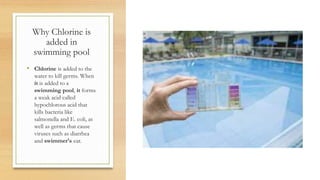
Group 7 elements
- 1. Why Chlorine is added in swimming pool • Chlorine is added to the water to kill germs. When it is added to a swimming pool, it forms a weak acid called hypochlorous acid that kills bacteria like salmonella and E. coli, as well as germs that cause viruses such as diarrhea and swimmer's ear.
- 2. Write the name of group 7 elements from the periodic table • The group 7 elements contains 5 elements and they are : • Fluorine • Chlorine • Bromine • Iodine • Astatine
- 3. Group 7 elements are non – metals. Suggest their physical properties • They do not conduct electricity. • They are poor conductors of heat. • They have low melting and boiling point
- 5. Melting and Boiling Point Element Melting point (*C) Boiling point (*C) State at 20 *C Colour Fluorine -220 -188 Gas Yellow Chlorine -101 -35 Gas Green Bromine -7 59 Liquid Dark red Iodine 114 184 Solid Solid-shiny grey- black vapour- purple
- 6. Valence electrons • How many electrons does fluorine and chlorine atom have?
- 7. Ionic bond • A bond formed between metal and non metal by losing or gaining an electron
- 8. Ionic bond – metal halides • When a metal join with non metal it gains or loses electron to form a compound. Halogens lose one electron and form an ionic bond with a metal to form metal halides
- 9. Metal + halogens – salt • Example • Sodium + chlorine ------ sodium chloride • Potassium + fluorine ----- Potassium fluoride • Iron + bromine ------- Iron bromide
- 10. Task 1:Arrange the group 1 elements with their respective colours symbols and state of matter • Task 2:Compare group 7 elements with the property of group 1 elements and group 2 elements • Task 3:Draw the ionic bond formation between group 1 element with fluorine and group 2 elements with fluorine. Write the name of the compound. Predict the chemical formula if group 1 element or group 2 elements react with group 7 elements.
- 11. Group 7 element exist as diatomic molecules or diatomic compounds. •Guess why?????
- 12. Identify the below chemical formula as compounds or molecules. • CH4- • H2- • Cl2 • C6H12O6 • NH4 • F2 • Br2
- 13. Learning Objectives • To understand what are diatomic molecules • To explain why group 7 elements exist as diatomic molecules. • To know about the intermolecular and intramolecular attraction between group 7 elements
- 14. Why Group 7 elements exist as molecules? • How many valence electron does group 7 elements have? • How many electrons does group 7 element need to complete its octet structure? • If two group 7 elements combine together can they complete its octet structure • Group 7 elements are one of the diatomic molecules.
- 15. List of diatomic molecules • Hydrogen (H2) • Nitrogen (N2) • Oxygen (O2) • Fluorine (F2) • Chlorine (Cl2) • Iodine (I2) • Bromine (Br2)
- 16. How to remember easily? • All Halogens exist as diatomic molecules.
- 18. Task 1:Separate the given chemical formulas as compounds or molecules • Task 3:Draw the intra molecular and intermolecular attraction between fluorine, hydrogen and oxygen. • Task 2:Draw the bonding of fluorine with another fluorine atom. Name other elements which also exist as diatomic molecules. Suggest an easy way to remember them.
- 19. The Group 7 Elements
- 20. Guess what? Fluorine bonds with fluorine Fluorine bonds with Lithium Fluorine bonds with hydrogen. What is the difference between each bonding?
- 21. Learning Objectives • To differentiate between ionic and covalent bonding of halogens • To draw the bonding between fluorine and fluorine atom • To write a chemical formula and write the name of the compound of ionic and covalent bonding compounds of halogens
- 22. Ionic bond of halogens with group 1 element • Sodium + chlorine • Sodium chloride
- 23. Lithium + Fluorine----- Lithium Fluoride
- 26. Task 1: Sort the given pieces of compounds as ionic bond and covalent bond. •Task 2: Draw any two ionic bond between group 1 elements and halogens. •Task 3: Draw a Venn diagram representing the similarities and differences between Ionic bond and covalent bond
- 27. Melting and Boiling Point • The group 7 element have low melting and boiling points compared to most metals. This is because they exist as molecules. • A strong force holds the two atoms of the molecule together. The forces between a molecules and its neighbours are weak. It is easy to separate the molecules of chlorine in the liquid state to form a gas. • The table in the previous page shows a trend in melting and boiling points. They increase from top to bottom of the group. This is because the atoms (and molecules) of the elements get bigger.
- 28. Covalent Bonding of group 7 elements • Group 7 elements donot exist as single atoms they are always found as molecules or compounds. • Ex F2 or Cl2
- 29. Review • Group 7 elements are also called as halogens • It has relatively low melting and boiling point • Group 7 elements are one of the diatomic molecules and have intermolecular attraction between the atoms. • They react with metals to form salt. • Only group in periodic table which have different states is halogens with different colours on burning
- 30. What do you mean by diatomic molecules? Other than group 7 elements name some other diatomic molecules • Diatomic molecules consist of two atoms bonded together. In contrast, monatomic elements consist of single atoms (e.g., Ar, He). Many compounds are diatomic, such as HCl, NaCl, and KBr. Diatomic compounds consist of two different elements. There are seven pure elements that form diatomic molecules.